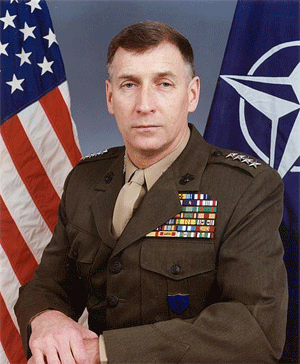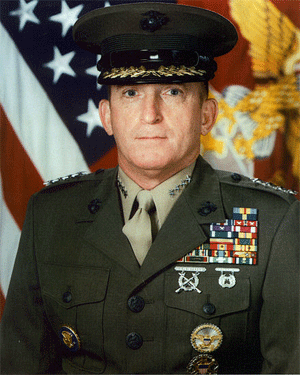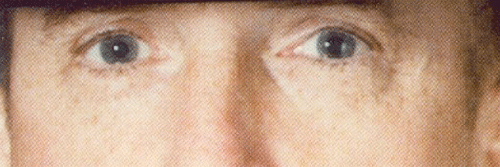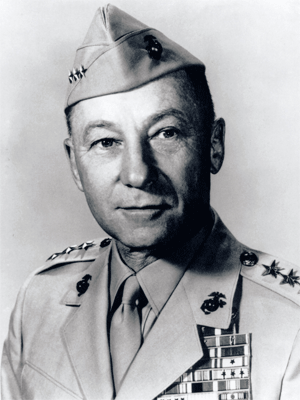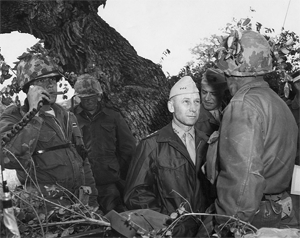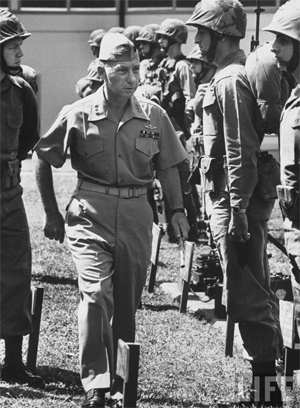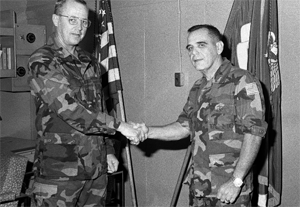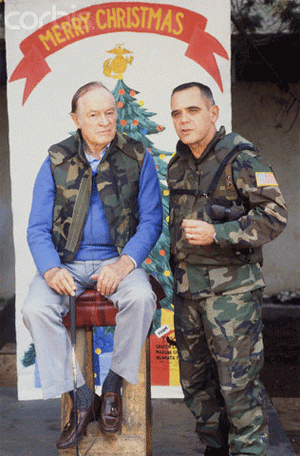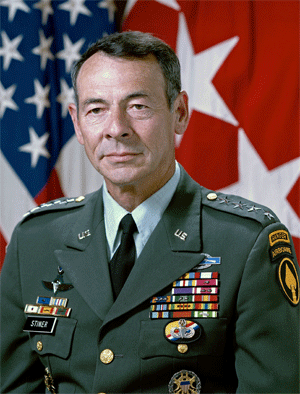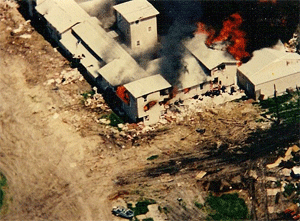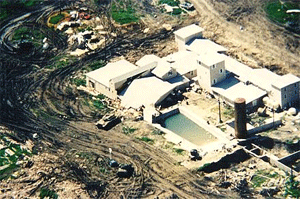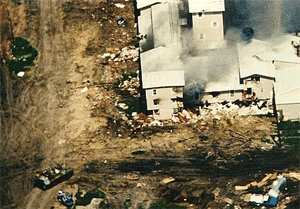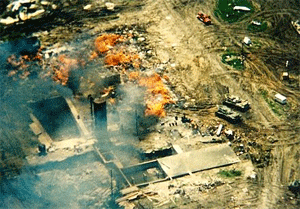Part 2 of 3
Chronology of events of April 19Time / Event
05:50 / Agents call the Branch Davidian compound to warn they are going to begin tank activity and advise residents "to take cover". Agents say the Branch Davidian who answered the phone did not reply but instead threw the phone and phone line out of the front door.
05:55 / The FBI Hostage Rescue Team deploys two armored CEVs to the buildings. CEV1 goes to the left of the buildings, CEV2 to the right.[65]
06:00 / FBI surveillance tapes from devices planted in the wall of the building record a man inside the compound saying "Everybody wake up, let's start to pray", then, "Pablo, have you poured it yet?" ... "Huh?" ... "Have you poured it yet?" ... "In the hallway" ... "Things are poured, right?" CEV1 receives orders to spray two bottles of tear gas into left corner of building.[65]
06:04 / Armored vehicle with ram and delivery device to pump tear gas into building with pressurized air rips into front wall just left of front door, leaving a hole 8 feet (2.4 m) high and 10 feet (3.0 m) wide. Agents claimed the holes allowed insertion of the gas as well as provided a means of escape. Agent sees shots from inside the compound directed at CEVs.[65]
06:10 / FBI surveillance tapes record "Don't pour it all out, we might need some later" and "Throw the tear gas back out." FBI negotiator Byron Sage is recorded saying "It's time for people to come out." Surveillance tapes record a man saying "What?", and then "No way."
06:12 / FBI surveillance tapes record Branch Davidians saying "They're gonna kill us", then "They don't want to kill us."
06:31 / The entire building is gassed.[65]
06:47 / The FBI Hostage Rescue Team fires plastic, non-incendiary tear gas rounds through windows.[65]
07:23 / FBI surveillance tapes record a male Branch Davidian saying, "The fuel has to go all around to get started." Then a second male says, "Well, there are two cans here, if that's poured soon."
07:30 / CEV1 is redeployed, breaching the building and inserting tear gas. Branch Davidians fire shots at CEV1.[65]
07:48 / On FBI tapes of agents recorded during the siege, an FBI Hostage Rescue Team agent requests permission to fire military-style tear gas shells to break through an underground concrete bunker. He receives permission and fires two shells.[65]
07:58 / CEV2, with battering ram, rips a hole into second floor of compound; minutes later another hole is punched into the rear of one of the buildings of the compound. The vehicles then withdraw.[65]
08:08 / Three pyrotechnic military tear gas rounds are shot at the concrete construction pit (not the concrete bunker), away and downwind from the main quarters, trying to penetrate the structure, but they bounce off.[66]:28–32 An agent in the CEV reports that one shell bounced off bunker and did not penetrate.[65][66]:30
08:24 / The audio portion of FBI videotape ends, at the request of the pilot.[65]
09:00 / The Branch Davidians unfurl a banner which reads "We want our phone fixed."
09:13 / CEV1 breaks through the front door to deliver more gas.[65]
09:20 / FBI surveillance records a meeting starting at 7:30 am between several unidentified males.[67]
UM: "They got two cans of Coleman fuel down there? Huh?"
UM: "Empty."
UM: "All of it?"
UM: "Nothing left."
10:00 / A man is seen waving a white flag on the southeast side of the compound. He is advised over loudspeakers that if he is surrendering he should come out. He does not. At the same time, a man believed to be Schneider comes out from the remains of the front door to retrieve the phone and phone line.
11:30 / The original CEV2 has mechanical difficulties (damaged tread); its replacement breaches through back side of compound.[65]
11:17 – 12:04 / According to the government, a series of remarks such as "I want a fire", "Keep that fire going", and "Do you think I could light this soon?" indicate that the Branch Davidians have started setting fire to the complex around 11:30.[66]:15–19[67]:287 Surviving Branch Davidians testified that Coleman fuel had been poured, and fire experts in Danforth's report agree "without question" that people inside the complex had started multiple accelerated fires.[66]:15–19, appendixes D and E
11:43 / Another gas insertion takes place, with the armored vehicle moving well into the building on the right rear side to reach the concrete interior room where the FBI Hostage Rescue Team believe the Branch Davidians are trying to avoid the gas.
11:45 / The wall on the right rear side of the building collapses.[65]
12:03 / An armored vehicle turret knocks away the first floor corner on the right side.
12:07 / The first visible flames appear in two spots in the front of the building, first on the left of the front door on the second floor (a wisp of smoke then a small flicker of flame), then a short time later on the far right side of the front of the building, and at a third spot on the back side. An FBI Hostage Rescue Team agent reported seeing a Branch Davidian member igniting a fire in the front door area.[66]:18
12:09 / Ruth Riddle exits with a computer disk in her jacket containing Koresh's Manuscript on the Seven Seals. A third fire is detected on first floor.[65]
12:10 / Flames spread quickly through the building, fanned by high winds. The building burns very quickly.
12:12 / An emergency call is placed regarding the fire. Two Waco Fire Department trucks are dispatched. Shortly after, the Bellmead Fire Department dispatches two trucks.
12:22 / Waco fire trucks arrive at the checkpoint, where they are halted (not being allowed to pass until 12:37);[68] Bellmead follows shortly after.
12:25 / There is a large explosion on the left side of the compound. One object hurtles into the air, bounces off the top of a bus, and lands on the grass.
12:30 / Part of the roof collapses. Around this time, there are several further explosions, and witnesses report the sound of gunfire, attributed by the FBI Hostage Rescue Team to live ammunition cooking off throughout the buildings because of the fire.
12:43 / According to fire department logs, fire trucks arrive at the compound.
12:55 / Fire begins to burn out. The entire compound is leveled.
15:45 / A law enforcement source states that David Koresh is dead.
Fatalities of April 19In all, 76 Branch Davidians died,[9] and nine survived the fire on April 19 (five others had been killed in the initial ATF raid, and their bodies were buried on the grounds; one had been killed by the ATF after the raid; and 35 had left during the FBI siege).[61]
A large concentration of bodies, weapons, and ammunition was found in the bunker. The Texas Rangers' arson investigator report assumes that many of the occupants were either denied escape from within or refused to leave until escape was not an option. It also mentions that the structural debris from the breaching operations on the west end of the building could have blocked a possible escape route through the tunnel system.[69] An independent investigation by two experts from the University of Maryland's Department of Fire Protection Engineering concluded that the compound residents had sufficient time to escape the fire, if they had so desired.[61]
Autopsies of the dead revealed that some women and children found beneath a fallen concrete wall of a storage room died of skull injuries. Autopsy photographs of other children locked in what appear to be spasmic death poses are consistent with cyanide poisoning, one of the results produced by burning CS gas.[43] The U.S. Department of Justice report indicated that only one body had traces of benzene, one of the components of solvent-dispersed CS gas, but that the gas insertions had finished nearly one hour before the fire started, and that it was enough time for solvents to dissipate from the bodies of the Branch Davidians that had inhaled the tear gas.[70]
Autopsy records also indicate that at least 20 Branch Davidians were shot, including five children under the age of 14. Three-year-old Dayland Gent was stabbed in the chest. The medical examiner who performed the autopsies believed these deaths were mercy killings by the Branch Davidians trapped in the fire with no escape. The expert retained by the U.S. Office of Special Counsel concluded that many of the gunshot wounds "support self-destruction either by overt suicide, consensual execution (suicide by proxy), or less likely, forced execution."[66]
Aftermath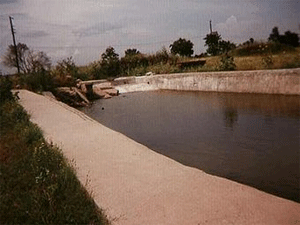
Remains of a swimming pool left on the grounds of Mount Carmel Center in 1997
The new ATF Director, John Magaw, criticized several aspects of the ATF raid. Magaw made the Treasury "Blue Book" report on Waco required reading for new agents. A 1995 Government Accountability Office report on use of force by federal law enforcement agencies observed that, "on the basis of Treasury's report on the Waco operation and views of tactical operations experts and ATF's own personnel, ATF decided in October 1995 that dynamic entry would only be planned after all other options have been considered and began to adjust its training accordingly."[71]
Nothing remains of the buildings today other than concrete foundation components, as the entire site was bulldozed two weeks after the end of the siege. Only a small chapel, built years after the siege, stands on the site.[72]
TrialThe events at Waco spurred both criminal prosecution and civil litigation. On August 3, 1993, a federal grand jury returned a superseding ten-count indictment against 12 of the surviving Branch Davidians. The grand jury charged, among other things, that the Branch Davidians had conspired to, and aided and abetted in, murder of federal officers, and had unlawfully possessed and used various firearms. The government dismissed the charges against one of the 12 Branch Davidians pursuant to a plea bargain.
After a jury trial lasting nearly two months, the jury acquitted four of the Branch Davidians on all charges. Additionally, the jury acquitted all of the Branch Davidians on the murder-related charges but convicted five of them on lesser charges, including aiding and abetting the voluntary manslaughter of federal agents.[73] Eight Branch Davidians were convicted on firearms charges.
The convicted Branch Davidians, who received sentences of up to 40 years,[74] were:
• Kevin A. Whitecliff—convicted of voluntary manslaughter and using a firearm during a crime.
• Jaime Castillo—convicted of voluntary manslaughter and using a firearm during a crime.
• Paul Gordon Fatta—convicted of conspiracy to possess machine guns and aiding Branch Davidian leader David Koresh in possessing machine guns.
• Renos Lenny Avraam (British national)—convicted of voluntary manslaughter and using a firearm during a crime.
• Graeme Leonard Craddock (Australian national)—convicted of possessing a grenade and using or possessing a firearm during a crime.
• Brad Eugene Branch—convicted of voluntary manslaughter and using a firearm during a crime.
• Livingstone Fagan (British national)—convicted of voluntary manslaughter and using a firearm during a crime.
• Ruth Riddle (Canadian national)—convicted of using or carrying a weapon during a crime.
• Kathryn Schroeder—sentenced to three years after pleading guilty to a reduced charge of forcibly resisting arrest.
Six of the eight Branch Davidians appealed both their sentences and their convictions. They raised a host of issues, challenging the constitutionality of the prohibition on possession of machine guns, the jury instructions, the district court's conduct of the trial, the sufficiency of the evidence, and the sentences imposed. The United States Court of Appeals for the Fifth Circuit vacated the defendants' sentences for use of machine guns, determining that the district court had made no finding that they had "actively employed" the weapons, but left the verdicts undisturbed in all other respects, in United States v. Branch,[75] 91 F.3d 699 (5th Cir. 1996), cert. denied (1997).
On remand, the district court found that the defendants had actively employed machine guns and re-sentenced five of them to substantial prison terms. The defendants again appealed. The Fifth Circuit Court of Appeals affirmed.[76] The Branch Davidians pressed this issue before the United States Supreme Court. The Supreme Court reversed, holding that the term "machine gun" in the relevant statute created an element of the offense to be determined by a jury, rather than a sentencing factor to be determined by a judge, as had happened in the trial court.[77] On September 19, 2000, Judge Walter Smith followed the Supreme Court's instructions and cut 25 years from the sentences of five convicted Branch Davidians, and five years from the sentence of another.[78] All Branch Davidians had been released from prison as of July 2007.[79]
Civil suitsSeveral of the surviving Branch Davidians, as well as more than a hundred family members of those who had died or were injured in the confrontation, brought civil suits against the United States government, numerous federal officials, the former governor of Texas Ann Richards, and members of the Texas Army National Guard. They sought monetary damages under the Federal Tort Claims Act, civil rights statutes, the Racketeer Influenced and Corrupt Organizations Act, and Texas state law. The bulk of these claims were dismissed because they were insufficient as a matter of law or because the plaintiffs could advance no material evidence in support of them.
The court, after a month-long trial, rejected the Branch Davidians' case. The court found that, on February 28, 1993, the Branch Davidians initiated a gun battle when they fired at federal officers who were attempting to serve lawful warrants.[80] ATF agents returned gunfire to the building, the court ruled, in order to protect themselves and other agents from death or serious bodily harm. The court found that the government's planning of the siege—i.e., the decisions to use tear gas against the Branch Davidians; to insert the tear gas by means of military vehicles; and to omit specific planning for the possibility that a fire would erupt—was a discretionary function for which the government could not be sued. The court also found that the use of tear gas was not negligent. Further, even if the United States government were negligent by causing damage to the buildings before the fires broke out, thus either blocking escape routes or enabling the fires to spread faster, that negligence did not legally cause the plaintiffs' injuries because the Branch Davidians started the fires.
The Branch Davidians appealed. Their contention was that the trial court judge, Walter S. Smith, Jr., should have recused himself from hearing their claims on account of his relationships with defendants, defense counsel, and court staff; prior judicial determinations; and comments during trial. The Fifth Circuit concluded that these allegations did not reflect conduct that would cause a reasonable observer to question Judge Smith's impartiality, and it affirmed the take-nothing judgment, in Andrade v. Chojnacki,[81] 338 F.3d 448 (5th Cir. 2003), cert. denied (2004).
British nationalsThirty-three British citizens were among the members of the Branch Davidians during the siege. Twenty-four of them were among the 80 Branch Davidian fatalities (in the raid of February 28 and the assault of April 19), including at least one child.[49] Two more British nationals who survived the siege were immediately arrested as "material witnesses" and imprisoned without trial for months.[74]
Derek Lovelock was held in McLennan County Jail for seven months, often in solitary confinement.[74] Livingstone Fagan, another British citizen, who was among those convicted and imprisoned, says he received multiple beatings at the hands of correctional officers, particularly at Leavenworth. There, Fagan claims to have been doused inside his cell with cold water from a high-pressure hose, after which an industrial fan was placed outside the cell, blasting him with cold air. Fagan was repeatedly moved between at least nine different facilities. He was strip-searched every time he took exercise, so he refused exercise. Released and deported back to the UK in July 2007, he still held on to his religious beliefs.[74]
Role of anti-cult activistsIn the weeks preceding the raid, Rick Ross, a self-described cult expert and deprogrammer affiliated with the Cult Awareness Network, appeared on major networks such as NBC[82] and CBS in regard to Koresh.[83] Ross later described his role in advising authorities about the Davidians and Koresh, and what actions should be taken to end the siege.[84] He was quoted as saying that he was consulted by the ATF[85] and he contacted the FBI on the March 4, 1993, requesting "that he be interviewed regarding his knowledge of cults in general and the Branch Davidians in particular". The FBI reports that it did not rely on Ross for advice whatsoever during the standoff, but that it did interview and received input from him. Ross also telephoned the FBI on March 27 and March 28, offering advice about negotiation strategies, suggesting that the FBI "attempt to embarrass Koresh by informing other members of the compound about Koresh's faults and failures in life, in order to convince them that Koresh was not the prophet they had been led to believe".[84] The ATF also contacted Ross in January 1993 for information about Koresh.[84]
Several writers have documented the Cult Awareness Network's role in relation to the government's decision-making concerning Waco.[82] Mark MacWilliams notes that several studies have shown how "self-styled cult experts like Ross, anticult organizations like the Cult Awareness Network (CAN), and disaffected Branch Davidian defectors like Breault played important roles in popularizing a harshly negative image of Koresh as a dangerous cult leader. Portrayed as "self-obsessed, egomaniacal, sociopathic and heartless", Koresh was frequently characterized as either a religious lunatic who doomed his followers to mass suicide or a con man who manipulated religion for his own bizarre personal advantage".[86] According to religious scholars Phillip Arnold and James Tabor who made an effort to help resolve the conflict, "the crisis need not have ended tragically if only the FBI had been more open to Religious Studies and better able to distinguish between the dubious ideas of Ross and the scholarly expertise".[87] In a New Yorker article in March 2014, writer Malcolm Gladwell wrote that Arnold and Tabor told the FBI that Koresh needed to be persuaded of an alternative interpretation of the Book of Revelation, one that does not necessarily involve a violent end. They made an audiotape which was played for Koresh, and seemed to convince him. However, the FBI waited only three days before beginning the assault, instead of an estimated two weeks for Koresh to complete a manuscript sparked by this alternate interpretation, and then come out peacefully.[88]
ControversiesRolland Ballestros, one of the agents assigned to the ATF door team that assaulted the front door, told Texas Rangers and Waco police that he thought the first shots came from the ATF dog team assigned to neutralize the Branch Davidians' dogs, but later at the trial he insisted that the Branch Davidians had shot first.[89] The Branch Davidians claimed that the ATF door team then opened fire at the door, and they returned fire in self-defense. An Austin Chronicle article noted, "Long before the fire, the Davidians were discussing the evidence contained in the doors. During the siege, in a phone conversation with the FBI, Steve Schneider, one of Koresh's main confidants, told FBI agents that 'the evidence from the front door will clearly show how many bullets and what happened'." Houston attorney Dick DeGuerin, who went inside Mount Carmel during the siege, testified at the trial that protruding metal on the inside of the right-hand entry door made it clear that the bullet holes were made by incoming rounds. DeGuerin also testified that only the right-hand entry door had bullet holes, while the left-hand entry door was intact. The government presented the left-hand entry door at the trial, claiming that the right-hand entry door had been lost. The left-hand door contained numerous bullet holes made by both outgoing and incoming rounds. Texas Trooper Sgt. David Keys testified that he witnessed two men loading what could have been the missing door into a U-Haul van shortly after the siege had ended, but he did not see the object itself. Michael Caddell, the lead attorney for the Branch Davidians' wrongful death lawsuit explained, "The fact that the left-hand door is in the condition it's in tells you that the right-hand door was not consumed by the fire. It was lost on purpose by somebody." Caddell offered no evidence to support this allegation, which has never been proved. However, fire investigators stated that it was "extremely unlikely" that the steel right door could have suffered damage in the fire much greater than did the steel left door, and both doors would have been found together. The right door remains missing, and the entire site was under close supervision by law enforcement officials until the debris—including both doors—had been removed.[90]
Helicopters had been obtained from the Alabama and Texas National Guard on the pretext that there was a drug laboratory at Mount Carmel.[31][91] There were, however, no drug-related charges on the arrest warrant served on the morning of February 28, 1993.[92][93] The official version of events has always stated that the helicopters were merely used as a diversion, that the crew only had 9 millimeter sidearms, and that no shots were made from them.[40]
Critics suggest that, during the final raid, the CS gas was injected into the building by armored vehicles in an unsafe manner, which could have started a fire. While two of the three fires were started well inside the building, away from where the CS gas was pumped in, survivor David Thibodeau claimed in a 1999 interview with Reason that damage to the building allowed the gas to spread, stating, "They started to break the walls, break the windows down, spread the CS gas out." The FBI had planted surveillance devices in the walls of the building, which captured a number of conversations which the government claims are evidence that the Davidians started the fire.[67]:287 The recordings were imperfect and many times difficult to understand, and the two transcriptions that were made had differences at many points.[67]:287 According to reporter Diana Fuentes, when the FBI's April 19 tapes were played in court during the Branch Davidian trials, few people heard what the FBI audio expert claimed to hear; the tapes "were filled with noise, and voices only occasionally were discernible. [...] The words were faint; some courtroom observers said they heard it, some didn't."[94] The Branch Davidians had given ominous warnings involving fire on several occasions.[95] This may or may not have been indicative of the Branch Davidians' future actions, but was the basis for the conclusion of Congress that the fire was started by the Branch Davidians, "absent any other potential source of ignition." This was prior to the FBI admission that pyrotechnics were used, but a yearlong investigation by the Office of the Special Counsel after that admission nonetheless reached the same conclusion, and no further congressional investigations followed. During a 1999 deposition for civil suits by Branch Davidian survivors, fire survivor Graeme Craddock was interviewed. He stated that he saw some Branch Davidians moving about a dozen one gallon (3.8 L) cans of fuel so they would not be run over by armored vehicles, heard talk of pouring fuel outside the building, and, after the fire had started, something that sounded like "light the fire" from another individual.[96] Professor Kenneth Newport's book The Branch Davidians of Waco attempts to prove that starting the fire themselves was pre-planned and consistent with the Branch Davidians' theology. He cites as evidence conversations the FBI recorded during the siege, testimonials of survivors Clive Doyle and Graeme Craddock, and the buying of diesel fuel one month before the start of the siege.[67]
Attorney General Reno had specifically directed that no pyrotechnic devices be used in the assault. Between 1993 and 1999, FBI spokesmen denied (even under oath) the use of any sort of pyrotechnic devices during the assault; however, pyrotechnic Flite-Rite CS gas grenades had been found in the rubble immediately following the fire. In 1999, FBI spokesmen were forced to admit that they had used the grenades; however, they claimed that these devices—which dispense CS gas through an internal burning process—had been used during an early morning attempt to penetrate a covered, water-filled construction pit 40 yards (35 m) away and were not fired into the building. According to FBI claims, the fires started approximately three hours after the grenades had been fired. When the FBI's documents were turned over to Congress for an investigation in 1994, the page listing the use of the pyrotechnic devices was missing. The failure for six years to disclose the use of pyrotechnics despite her specific directive led Reno to demand an investigation. A senior FBI official told Newsweek that as many as 100 FBI agents had known about the use of pyrotechnics, but no one spoke up until 1999.[65] On May 12, less than a month after the incident, Texas state authorities bulldozed the site, rendering further gathering of forensic evidence impossible.
The FBI received contradictory reports on the possibility of Koresh's suicide and was not sure about whether he would commit suicide. The evidence made them believe that there was no possibility of mass suicide, with Koresh and Schneider repeatedly denying to the negotiators that they had plans to commit mass suicide, and people leaving the compound saying that they had seen no preparations for such a thing.[55] There was a possibility that some of his followers would follow Koresh if he committed suicide.[55] According to Alan A. Stone's report, during the siege the FBI used an incorrect psychiatric perspective to evaluate Branch Davidians' responses, which caused them to over-rely on Koresh's statements that they would not commit suicide. According to Stone, this incorrect evaluation caused the FBI to not ask pertinent questions to Koresh and to others on the compound about whether they were planning a mass suicide. A more pertinent question would have been, "What will you do if we tighten the noose around the compound in a show of overwhelming power, and using CS gas, force you to come out?"[45] Stone wrote:
The tactical arm of federal law enforcement may conventionally think of the other side as a band of criminals or as a military force or, generically, as the aggressor. But the Branch Davidians were an unconventional group in an exalted, disturbed, and desperate state of mind. They were devoted to David Koresh as the Lamb of God. They were willing to die defending themselves in an apocalyptic ending and, in the alternative, to kill themselves and their children. However, these were neither psychiatrically depressed, suicidal people nor cold-blooded killers. They were ready to risk death as a test of their faith. The psychology of such behavior—together with its religious significance for the Branch Davidians—was mistakenly evaluated, if not simply ignored, by those responsible for the FBI strategy of "tightening the noose". The overwhelming show of force was not working in the way the tacticians supposed. It did not provoke the Branch Davidians to surrender, but it may have provoked David Koresh to order the mass-suicide.[45]
Danforth ReportThe Oklahoma City bombing in April 1995 caused the media to revisit many of the questionable aspects of the government's actions at Waco, and many Americans who previously supported those actions began asking for an investigation.[97] By 1999—as a result of certain aspects of the documentaries discussed above, as well as allegations made by advocates for Branch Davidians during litigation—public opinion held that the federal government had engaged in serious misconduct at Waco. A Time poll conducted on August 26, 1999, for example, indicated that 61 percent of the public believed that federal law enforcement officials started the fire at the Branch Davidian complex. In September 1999, Attorney General Reno appointed former U.S. Senator John C. Danforth as Special Counsel to investigate the matter. In particular, the Special Counsel was directed to investigate charges that government agents started or spread the fire at the Mount Carmel complex, directed gunfire at the Branch Davidians, and unlawfully employed the armed forces of the United States. A yearlong investigation ensued, during which the Office of the Special Counsel interviewed 1,001 witnesses, reviewed over 2.3 million pages of documents, and examined thousands of pounds of physical evidence.
In the "Final report to the Deputy Attorney General concerning the 1993 confrontation at the Mt. Carmel Complex, Waco Texas" of November 8, 2000, Special Counsel Danforth concluded that the allegations were meritless. The report found, however, that certain government employees had failed to disclose during litigation against the Branch Davidians the use of pyrotechnic devices at the complex, and had obstructed the Special Counsel's investigation. Disciplinary action was pursued against those individuals. Allegations that the government started the fire were based largely on an FBI agent's having fired three "pyrotechnic" tear gas rounds, which are delivered with a charge that burns. The Special Counsel concluded that the rounds did not start or contribute to the spread of the fire, based on the finding that the FBI fired the rounds nearly four hours before the fire started, at a concrete construction pit partially filled with water, 75 feet (23 m) away and downwind from the main living quarters of the complex. The Special Counsel noted, by contrast, that recorded interceptions of Branch Davidian conversations included such statements as "David said we have to get the fuel on" and "So we light it first when they come in with the tank right [...] right as they're coming in." Branch Davidians who survived the fire acknowledged that other Branch Davidians started the fire. FBI agents witnessed Branch Davidians pouring fuel and igniting a fire, and noted these observations contemporaneously. Lab analysis found accelerants on the clothing of Branch Davidians, and investigators found deliberately punctured fuel cans and a homemade torch at the site. Based on this evidence and testimony, the Special Counsel concluded that the fire was started by the Branch Davidians.
Charges that government agents fired shots into the complex on April 19, 1993, were based on forward looking infrared (FLIR) video recorded by the Night Stalkers aircraft. These tapes showed 57 flashes, with some occurring around government vehicles that were operating near the complex. The Office of Special Counsel conducted a field test of FLIR technology on March 19, 2000, to determine whether gunfire caused the flashes. The testing was conducted under a protocol agreed to and signed by attorneys and experts for the Branch Davidians and their families, as well as for the government. Analysis of the shape, duration, and location of the flashes indicated that they resulted from a reflection off debris on or around the complex, rather than gunfire. Additionally, independent expert review of photography taken at the scene showed no people at or near the points from which the flashes emanated. Interviews of Branch Davidians, government witnesses, filmmakers, writers, and advocates for the Branch Davidians found that none had witnessed any government gunfire on April 19. None of the Branch Davidians who died on that day displayed evidence of having been struck by a high velocity round, as would be expected had they been shot from outside of the complex by government sniper rifles or other assault weapons.
In view of this evidence, the Special Counsel concluded that the claim that government gunfire occurred on April 19, 1993, amounted to "an unsupportable case based entirely upon flawed technological assumptions." The Special Counsel considered whether the use of active duty military at Waco violated the Posse Comitatus Act or the Military Assistance to Law Enforcement Act. These statutes generally prohibit direct military participation in law enforcement functions but do not preclude indirect support such as lending equipment, training in the use of equipment, offering expert advice, and providing equipment maintenance. The Special Counsel noted that the military provided "extensive" loans of equipment to the ATF and FBI, including—among other things—two tanks, the offensive capability of which had been disabled. Additionally, the military provided limited advice, training, and medical support. The Special Counsel concluded that these actions amounted to indirect military assistance within the bounds of applicable law. The Texas National Guard, in its state status, also provided substantial loans of military equipment, as well as performing reconnaissance flights over the Branch Davidian complex. Because the Posse Comitatus Act does not apply to the National Guard in its state status, the Special Counsel determined that the National Guard lawfully provided its assistance.
David Koresh's lawyer called the Danforth report a whitewash.[98] Ramsey Clark—a former U.S. Attorney General, who represented several Branch Davidian survivors and relatives in a civil lawsuit—said that the report "failed to address the obvious": "History will clearly record, I believe, that these assaults on the Mt. Carmel church center remain the greatest domestic law enforcement tragedy in the history of the United States."[99]
Equipment and manpower
Government agencies• Raid (February 28): 75 federal agents (ATF and FBI); 3 helicopters manned by 10 Texas National Guardcounter-drug personnel as distraction during the raid and filming.[91][100] Ballistic protection equipment, fire retardant clothing, regular flashlights, regular cameras (i.e. flash photography), pump-action shotguns and flashbang grenades,[101] 9 mm handguns, 9 mm MP5 submachine guns, .223 AR-15 rifles, a .308 bolt-action sniper rifle.[102]
• Siege (March 1 through April 18): Hundreds of federal agents; 2 Bell UH-1 Iroquois helicopters.[103]
• Assault (April 19): Hundreds of federal agents; military vehicles (with their normal weapon systems removed): 9–10 M3 Bradley infantry fighting vehicles, 4–5 M728 Combat Engineering Vehicles (CEVs) armed with CS gas, 2 M1A1 Abrams main battle tanks, 1 M88 tank retriever.[100][103]
• Support:[100] 1 Britten-Norman Defender surveillance aircraft;[104] a number of Texas National Guard personnel for maintenance of military vehicles and training on the use of the vehicles and their support vehicles (Humvees and flatbed trucks); surveillance from Texas National Guard counter-drug UC-26 surveillance aircraft and from Alabama National Guard; 10 active-duty U.S. Army Special Forces (Delta Force) soldiers as observers and trainers (also present during assault); 2 senior U.S. Army officers as advisers, 2 members of the British Army's 22nd Special Air Service (SAS) Regiment as observers;[105] 50+ men in total.[106]
Branch DavidiansThe Branch Davidians were well armed with small arms,[106][107] possessing 305 total firearms, including numerous rifles (semi-automatic AK-47s and AR-15s), shotguns, revolvers and pistols;[61][66][108] 46 semi-automatic firearms modified to fire in full automatic mode (included on above list): 22 AR-15 (erroneously referred to as M16), 20 AK-47, 2 HK SP-89, 2 M-11/Nine[66][108] Texas Rangers reported "at least 16 AR-15 rifles,";[61] 2 AR-15 lower receivers modified to fire in full automatic mode;[108] 39 "full auto sears" devices used to convert semi-automatic weapons into automatic weapons; parts for fully automatic AK-47 and M16 rifles; 30-round magazines and 100-round magazines for M16 and AK-47 rifles; pouches to carry large ammunition magazines; substantial quantities of ammunition of various sizes.
Other items found at the compound included about 1.9 million rounds of "cooked off" ammunition;[61] grenade launcher parts; flare launchers; gas masks and chemical warfare suits; night vision equipment; hundreds of practice hand grenade hulls and components (including more than 200 inert M31 practice rifle grenades, more than 100 modified M-21 practice hand grenade bodies, 219 grenade safety pins and 243 grenade safety levers found after the fire);[108] Kevlar helmets and bulletproof vests; 88 lower receivers for the AR-15 rifle; and approximately 15 sound suppressors or silencers (the Treasury reports lists 21 silencers,[108] Texas Rangers report that at least six items had been mislabeled and were actually 40 mm grenades or flash bang grenades from manufacturers who sold those models to the ATF or FBI exclusively;[109][110] former Branch Davidian Donald Bunds testified he had manufactured silencers under direct orders of Koresh).[37]
The ATF knew that the Branch Davidians had a pair of .50 caliber rifles, so they asked for Bradley armored vehicles, which could resist that caliber.[111] During the siege, Koresh said that he had weapons bigger than .50 rifles and that he could destroy the Bradleys, so they were supplemented with two Abrams tanks and five M728 vehicles.[111][112] The Texas Rangers recovered at least two .50 caliber weapons from the remains of the compound.[61][66] There is the question of whether the Branch Davidians actually fired the .50 caliber rifles during the raid or during the assault. Various groups supporting gun bans, such as Handgun Control Incorporated and the Violence Policy Center have claimed that the Branch Davidians had used .50 caliber rifles and that therefore these types of firearms should be banned.[113][114] The ATF claims such rifles were used against ATF agents the day of the search. Several years later, the General Accounting Office, in response to a request from Henry Waxman, released a briefing paper titled "Criminal Activity Associated with .50 Caliber Semiautomatic Rifles" which repeated the ATF's claims that the Branch Davidians used .50 caliber rifles during the search.[115] FBI Hostage Rescue Team snipers reported sighting one of the weapons, readily identifiable by its distinctive muzzle brake, during the siege.[116]
Legacy
Oklahoma City bombingTimothy McVeigh cited the Waco incident as a primary motivation[117] for the Oklahoma City bombing, his April 19, 1995, truck bomb attack that destroyed the Alfred P. Murrah Federal Building, a U.S. government office complex in downtown Oklahoma City, and destroyed or damaged numerous other buildings in the vicinity. The attack claimed 168 lives (including 19 children under age 6) and left over 600 injured in the deadliest act of terrorism on U.S. soil prior to the September 11 attacks, and as of 2018 it remains the deadliest act of domestic terrorism in American history.[118] Within days after the bombing, McVeigh and Terry Nichols were both taken into custody for their roles in the bombing. Investigators determined that the two were both sympathizers of an anti-government militia movement and that their motive was to avenge the government's handling of the Waco and Ruby Ridge incidents.[119] McVeigh testified that he chose the date of April 19 because it was the second anniversary of the deadly fire at Mount Carmel. In March 1993, McVeigh drove from Arizona to Waco in order to observe the federal standoff. Along with other protesters, he was photographed by the FBI.[120] A courtroom reporter also claims to have seen McVeigh outside the courthouse at Waco, selling anti-government bumper stickers.[121]
Events matching the dateOther events sharing the date of fire at Mt. Carmel have been mentioned in discussions of the Waco siege. Eight years prior to the Waco fire, the ATF and FBI raided another compound of a religious cult: The Covenant, the Sword, and the Arm of the Lord. Some ATF agents who were present at that raid were present at Waco. The April 20, 1999, Columbine High School massacre might have been timed to mark either an anniversary of the FBI's assault at Waco or Adolf Hitler's birthday.[122] Some of the connections appear coincidental. April 19 was the date from the American Revolution's opening battles ("the shot heard round the world"). On April 17, 2013, a fertilizer plant exploded at West near Waco,[123] two days after the Boston Marathon bombings that some speculatively connected to an upcoming 20th anniversary of the Waco incident of 1993, as well as to an anniversary of the Virginia Tech massacre of April 16, 2007.[124][125]


